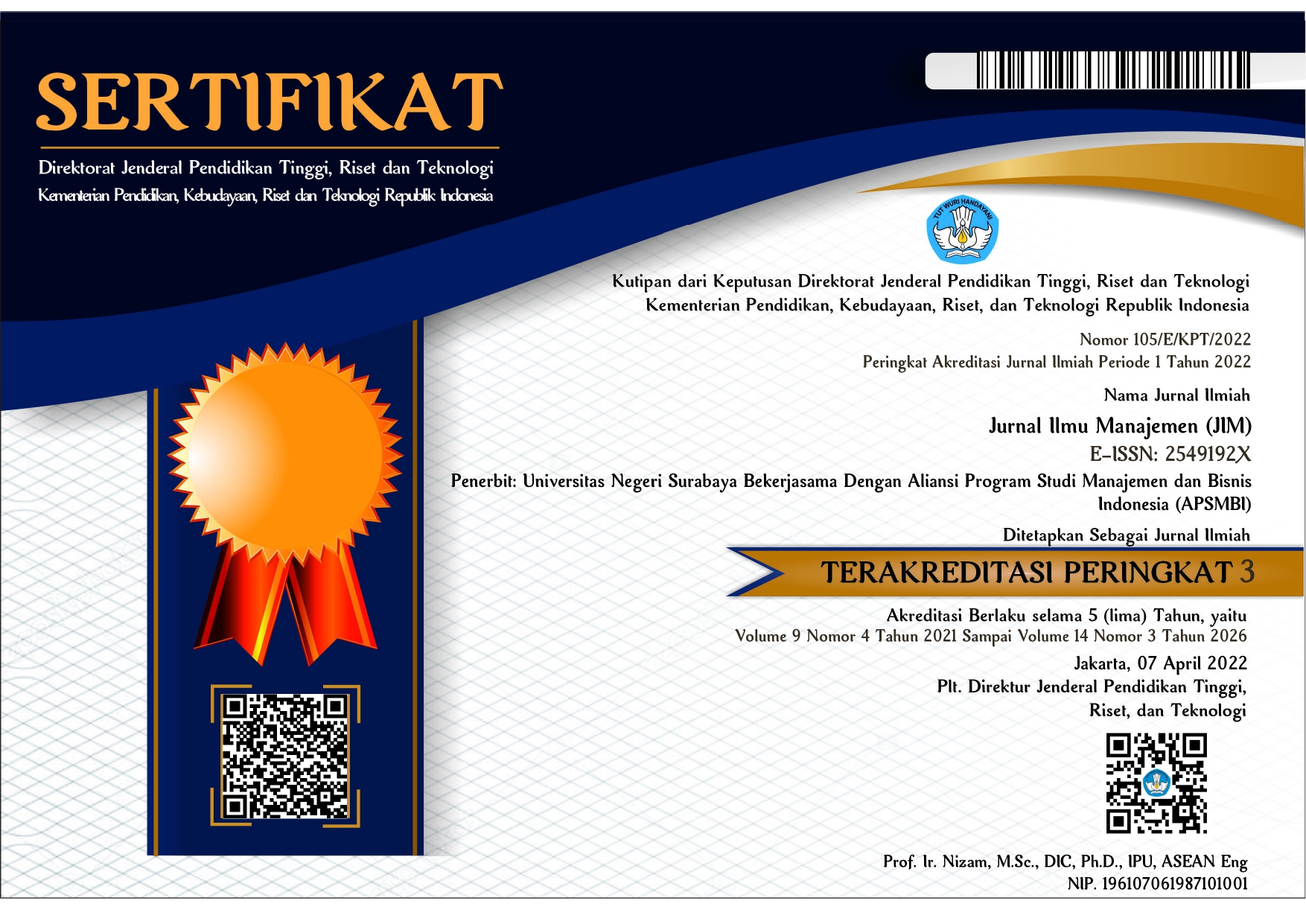Pengaruh Rasio Keuangan dan Makro Ekonomi terhadap Harga Saham pada Perusahaan Sektor Consumer Goods di BEI
DOI:
https://doi.org/10.26740/jim.v9n4.p1633-1643Keywords:
leverage ratio, macro economic, market value ratio, profitability ratio, stock priceAbstract
This research examines the relation of financial ratio and macroeconomics to stock price. The financial ratios used in this research are the return on assets (ROA), debt to assets ratio (DAR), debt to equity ratio (DER), dan price earning ratio (PER). However, the macroeconomy uses inflation, Bank Indonesia rate, and exchange rate. The research sample uses secondary data such as annual reporting from consumer goods companies listed in Indonesia Stock Exchange (IDX). Twenty-eight companies were used as a sample in this research, using the purposive sampling technique. This research uses multiple regression analysis and uses SPSS 24.0 as a tool. This research shows that ROA, PER, and inflation had no significant influence on the stock price. On the other hand, DAR, DER, Bank Indonesia rate, and exchange rate significantly influenced the stock price. ROA does not have a significant influence on stock price can be caused by investors' view that ROA can be changed not only driven by corporate profits but can also be caused by the changes of corporate assets. So the decline in ROA does not always reflect a decrease in corporate profits but can be caused by an increase in corporate investments. PER does not have a significant influence on stock price can be caused by the high level of investor confidence in the prospects of consumer goods sector companies because the consumer goods sector contains companies that produce consumption needs. While inflation does not have a significant influence on stock price can be caused by the view of investors that inflation in the long term will not endanger the funds of investors who are in the capital market.
References
Amarasinghe, AAMD. (2015). Dynamic Relationship between Interest Rate and Stock Price: Empirical Evidence from Colombo Stock Exchange. International Journal of Business and Social Science, 6. 4, 92-97.
Amin, Muhammad Zuhdi. (2012). Pengaruh Tingkat Inflasi, Suku Bunga SBI, Nilai Kurs Dollar (USD/IDR), dan Indeks Dow Jones (DJIA) terhadap Pergerakan Indeks Harga Saham Gabungan di Bursa Efek Indonesia (BEI) Periode 2008-2011. Jurnal Ilmiah FEB UB, 1(1). 1-17.
Aurora, Tona, dan Riyadi, Agus. (2013). Pengaruh Inflasi, Suku Bunga, dan urs Terhadap Indeks LQ45 di Bursa Efek Indonesia Periode Tahun 2007-2011. Jurnal Dinamika Manajemen, 1. (3). 183-197
Beik, Irfan Syauqi, dan Fatmawati, Sri Wulan. (2014). Pengaruh Indeks Harga Saham Syariah Internasional dan Variabel Makroekonomi terhadap Jakarta Islamic Index. Al-Iqtishad Jurnal Ilmu Ekonomi Syariah, 6. 2, 155-178.
Brigham, Eugene F., dan Houston, Joel F. (2010). Dasar-Dasar Manajemen Keuangan. Edisi Sebelas. Jakarta: Salemba Empat.
Fahmi, Irham. (2015). Manajemen Investasi. Edisi Kedua. Jakarta: Salemba Empat
Fauzian, Rizkie. (2017). Perjalanan Rupiah vs Dolar AS Sepanjang 2017, Terombang-ambing di Kisaran Rp13.600/USD. https://economy.okezone.com/read/2017/12/12/278/1829334/perjalanan-rupiah-vs-dolar-as-sepanjang-2017-terombang-ambing-di-kisaran-rp13-600-usd, diakses pada 1 Juni 2021.
Hanafi, Mamduh. (2004). Manajemen Keuangan. Yogyakarta: BPFE UGM.
Herdiansyah, Haris. (2010). Metodologi Penelitian Kuantitatif. Jakarta: Salemba Humanika.
Hopman, C. (2007). Do supply and demand drive stock prices?. Quantitative Finance, 7(1), 37-53.
Husnan, Suad, dan Pudjiastuti, Enny. (2006). Dasar-Dasar Manajemen Keuangan. Edisi Kelima. Yogyakarta: UPP STIM YKPN.
Indonesia, Bank. (2017). BI Rate. Diakses Pada 15 Maret, 2017, dari http://www.bi.go.id/id/moneter/bi-rate/penjelasan/Contents/Default.aspx
Islam, M. A. (2013). Impact of inflation on import: An empirical study. International Journal of Economics, Finance and Management Sciences, 1(6), 299-309.
Jogiyanto, H. M. (2010). Teori Portofolio dan Analisis Investasi. Edisi Ketujuh. Yogyakarta: BPFE.
Kasmir. (2015). Analisis Laporan Keuangan. Jakarta: PT. RajaGrafindo Persada.
Kewal, Suramaya Suci. (2012). Pengaruh Inflasi, Suku Bunga, Kurs, dan Pertumbuhan PDB Terhadap Indeks Harga Saham Gabungan. Jurnal Economia, Vol. 8. No. 1, 53-64.
Moeljadi. (2006). Manajemen Keuangan Pendekatan Kuantitatif dan Kualitatif. Edisi Pertama. Malang: Bayu Media Publishing.
Munawir, S. (2004). Analisis Laporan Keuangan. Edisi Keempat. Yogyakarta: Liberty.
Oktarina, Dian. (2016). Pengaruh Beberapa Indeks Saham Global dan Indikator Makroekonomi terhadap Pergerakan IHSG. Journal of Business & Banking, 5. 2, 163-182.
Permana, Yogi, dan Sularto, Lana. (2008). Analisis Pengaruh Fundamental Keuangan, Tingkat Bunga SBI dan Tingkat Inflasi Terhadap Pergerakan Harga Saham. Jurnal Ilmiah Ekonomi Bisnis Universitas Gunadarma, 13. (2).103-111.
Safitri, Abied Luthfi. (2013). Pengaruh Earning Per Share, Price Earning Ratio, Return On Asset, Debt To Equity Ratio dan Market Value Added Terhadap Harga Saham Dalam Kelompok Jakarta Islamic Index. Management Analysis Journal, 2 (2). 1-8.
Samuelson, Paul A., dan Nordhaus, William D. (2004). Ilmu Makro Ekonomi. Edisi Ke-17. Jakarta: PT. Media Global Edukasi.
Sudana, I Made. (2011). Manajemen Keuangan Perusahaan Teori & Praktik. Jakarta: Erlangga.
Susilawati, Christine Dwi Karya. (2012). Analisis Perbandingan Pengaruh Likuiditas, Solvabilitas, dan Profitabilitas Terhadap Harga Saham pada Perusahaan LQ45. Jurnal Akuntansi, 4. 2, 165-174.
Viandita, Tamara Oca, Suhadak, dan Husaini, Achmad. (2013). Pengaruh Debt Ratio (DR), Price to Earning Ratio (PER), Earning Per Share (EPS), dan Size Terhadap Harga Saham (Studi pada Perusahaan Industri yang Terdaftar di Bursa Efek Indonesia). Jurnal Administrasi Bisnis (JAB), Vol. 1. No. 2, 113-121.
Widyatmini, dan Damanik, Valentino. (2012). Pengaruh Economic Value Added (EVA) dan Analisis Fundamental Terhadap Harga Saham (Studi Pada Sektor Industri Perdagangan Retail). E-Journal Ekonomi, Universitas Gunadarma.14(1).39-50.
Yogaswari, Dhira Dwijayanti, Nugroho, Anggoro Budi, dan Astuti, Novika Candra. (2012). The Effect of Macroeconomic Variables on Stock Price Volatility: Evidence from Jakarta Composite Index, Agriculture, and Basic Industry Sector. Journal of Business and Management, 46, 96-100.
Zhao, Hua. (2009). Dynamic Relationship Between Exchange Rate and Stock Price: Evidence from China. Research in International Business and Finance, 24. 2, 103-112.
Zuliarni, Sri. (2012). Pengaruh Kinerja Keuangan terhadap Harga Saham pada Perusahaan Mining And Mining Service di Bursa Efek Indonesia (BEI). Jurnal Aplikasi Bisnis, 3. 1, 36-48.
Downloads
Published
How to Cite
Issue
Section
License

This work is licensed under a Creative Commons Attribution-NonCommercial 4.0 International License.
 Abstract views: 965
,
Abstract views: 965
, PDF Downloads: 581
PDF Downloads: 581










